THINK BIG: Innovation Project - Business Innovation in Australia
VerifiedAdded on 2021/06/16
|6
|1328
|28
Project
AI Summary
This project, titled "THINK BIG," focuses on innovation within the apparel industry, specifically addressing customer challenges when purchasing clothes. The student identifies the problem of customer reluctance to browse retail stores or online apps and proposes the creation of virtual trial rooms as a solution. The project details the innovation process, breaking it down into stages: idea generation and mobilization, advocacy and screening, experimentation, commercialization, and diffusion and implementation. The justification for each stage is provided, emphasizing the importance of customer needs and market analysis. The project aims to help the business adapt to changing customer preferences, sustain growth, and expand beyond borders. The student provides a conclusion that reinforces the value of continuous innovation and customer-centric approaches. The project uses references to support the discussion.

Running head: THINK BIG
THINK BIG
Name of the student
Name of the university
Author note
THINK BIG
Name of the student
Name of the university
Author note
Paraphrase This Document
Need a fresh take? Get an instant paraphrase of this document with our AI Paraphraser
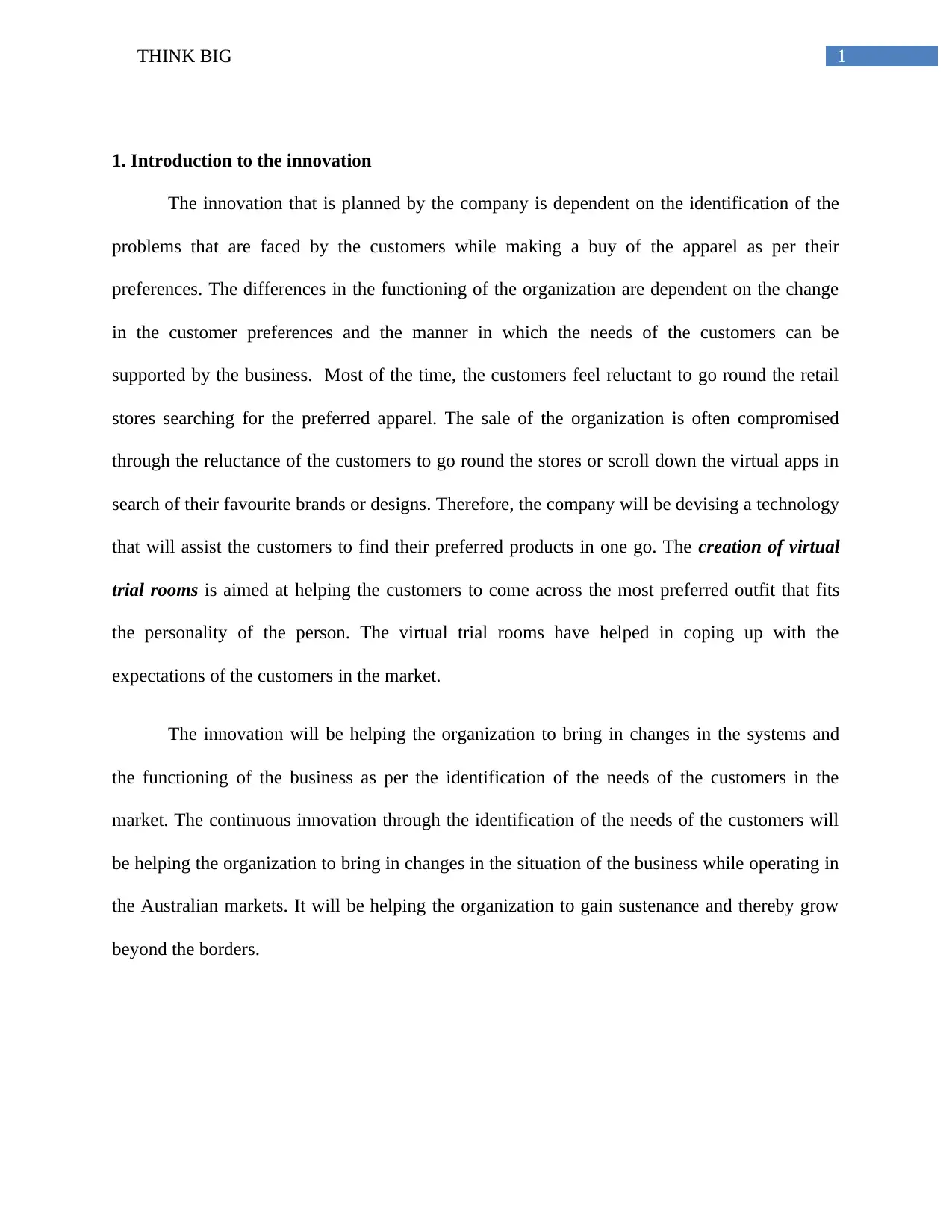
1THINK BIG
1. Introduction to the innovation
The innovation that is planned by the company is dependent on the identification of the
problems that are faced by the customers while making a buy of the apparel as per their
preferences. The differences in the functioning of the organization are dependent on the change
in the customer preferences and the manner in which the needs of the customers can be
supported by the business. Most of the time, the customers feel reluctant to go round the retail
stores searching for the preferred apparel. The sale of the organization is often compromised
through the reluctance of the customers to go round the stores or scroll down the virtual apps in
search of their favourite brands or designs. Therefore, the company will be devising a technology
that will assist the customers to find their preferred products in one go. The creation of virtual
trial rooms is aimed at helping the customers to come across the most preferred outfit that fits
the personality of the person. The virtual trial rooms have helped in coping up with the
expectations of the customers in the market.
The innovation will be helping the organization to bring in changes in the systems and
the functioning of the business as per the identification of the needs of the customers in the
market. The continuous innovation through the identification of the needs of the customers will
be helping the organization to bring in changes in the situation of the business while operating in
the Australian markets. It will be helping the organization to gain sustenance and thereby grow
beyond the borders.
1. Introduction to the innovation
The innovation that is planned by the company is dependent on the identification of the
problems that are faced by the customers while making a buy of the apparel as per their
preferences. The differences in the functioning of the organization are dependent on the change
in the customer preferences and the manner in which the needs of the customers can be
supported by the business. Most of the time, the customers feel reluctant to go round the retail
stores searching for the preferred apparel. The sale of the organization is often compromised
through the reluctance of the customers to go round the stores or scroll down the virtual apps in
search of their favourite brands or designs. Therefore, the company will be devising a technology
that will assist the customers to find their preferred products in one go. The creation of virtual
trial rooms is aimed at helping the customers to come across the most preferred outfit that fits
the personality of the person. The virtual trial rooms have helped in coping up with the
expectations of the customers in the market.
The innovation will be helping the organization to bring in changes in the systems and
the functioning of the business as per the identification of the needs of the customers in the
market. The continuous innovation through the identification of the needs of the customers will
be helping the organization to bring in changes in the situation of the business while operating in
the Australian markets. It will be helping the organization to gain sustenance and thereby grow
beyond the borders.
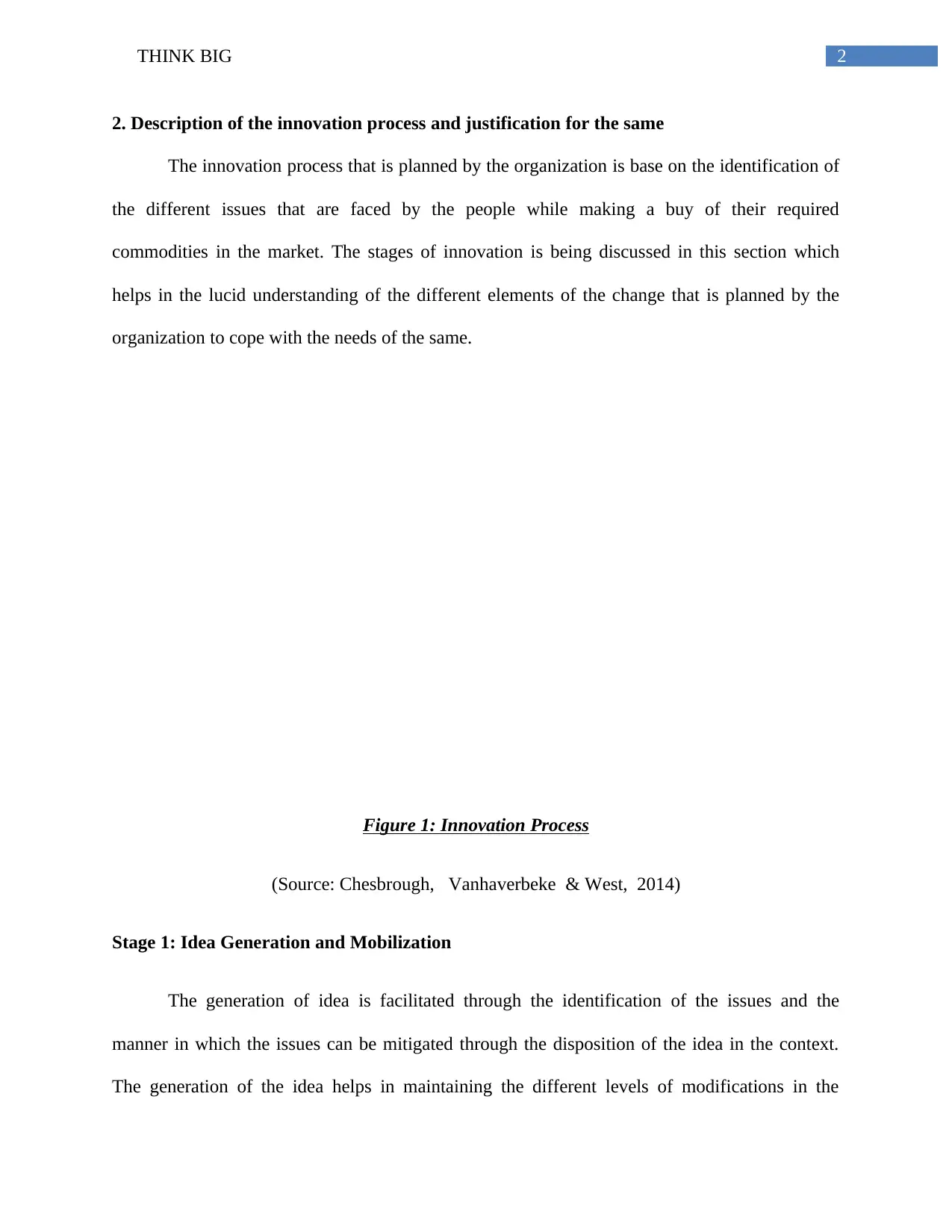
2THINK BIG
2. Description of the innovation process and justification for the same
The innovation process that is planned by the organization is base on the identification of
the different issues that are faced by the people while making a buy of their required
commodities in the market. The stages of innovation is being discussed in this section which
helps in the lucid understanding of the different elements of the change that is planned by the
organization to cope with the needs of the same.
Figure 1: Innovation Process
(Source: Chesbrough, Vanhaverbeke & West, 2014)
Stage 1: Idea Generation and Mobilization
The generation of idea is facilitated through the identification of the issues and the
manner in which the issues can be mitigated through the disposition of the idea in the context.
The generation of the idea helps in maintaining the different levels of modifications in the
2. Description of the innovation process and justification for the same
The innovation process that is planned by the organization is base on the identification of
the different issues that are faced by the people while making a buy of their required
commodities in the market. The stages of innovation is being discussed in this section which
helps in the lucid understanding of the different elements of the change that is planned by the
organization to cope with the needs of the same.
Figure 1: Innovation Process
(Source: Chesbrough, Vanhaverbeke & West, 2014)
Stage 1: Idea Generation and Mobilization
The generation of idea is facilitated through the identification of the issues and the
manner in which the issues can be mitigated through the disposition of the idea in the context.
The generation of the idea helps in maintaining the different levels of modifications in the
⊘ This is a preview!⊘
Do you want full access?
Subscribe today to unlock all pages.

Trusted by 1+ million students worldwide
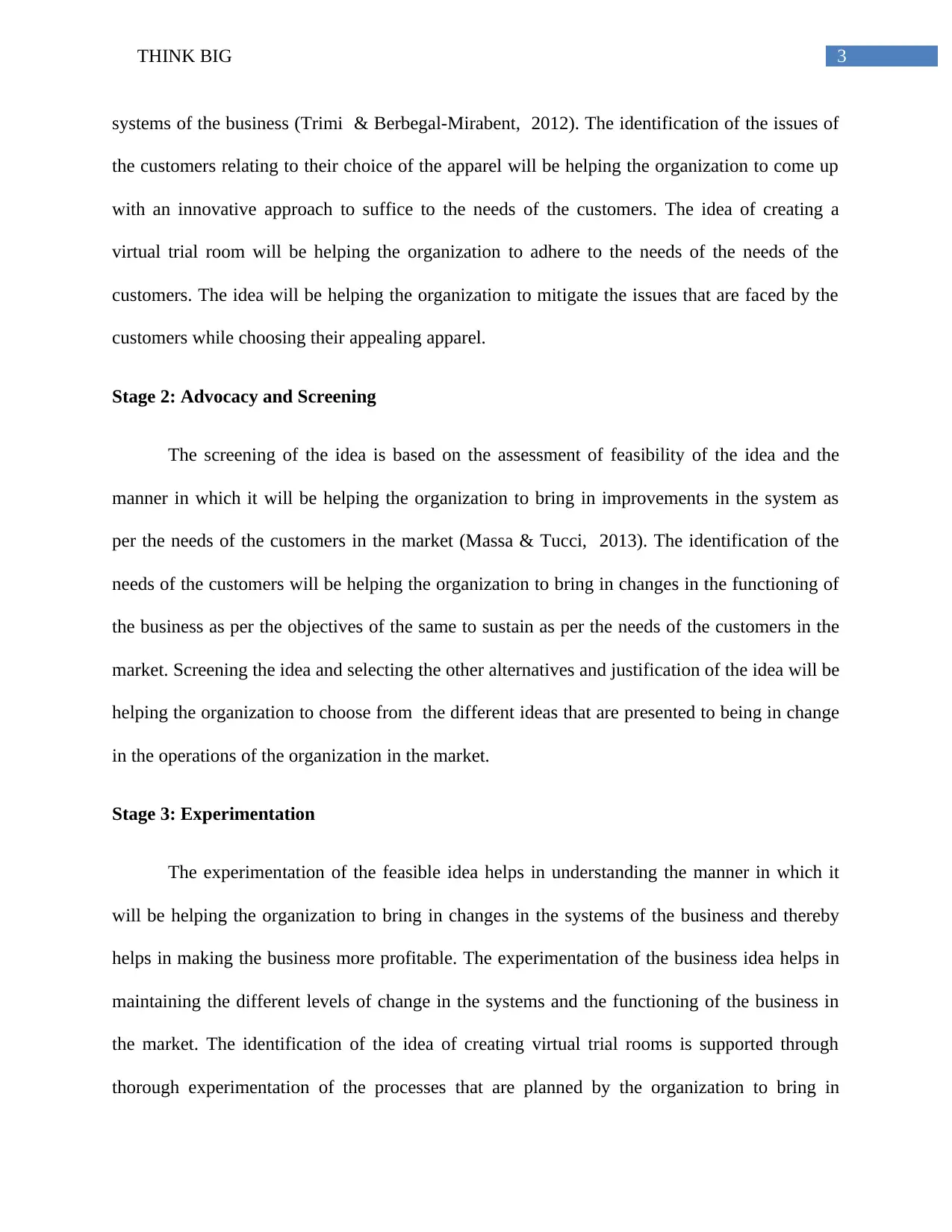
3THINK BIG
systems of the business (Trimi & Berbegal-Mirabent, 2012). The identification of the issues of
the customers relating to their choice of the apparel will be helping the organization to come up
with an innovative approach to suffice to the needs of the customers. The idea of creating a
virtual trial room will be helping the organization to adhere to the needs of the needs of the
customers. The idea will be helping the organization to mitigate the issues that are faced by the
customers while choosing their appealing apparel.
Stage 2: Advocacy and Screening
The screening of the idea is based on the assessment of feasibility of the idea and the
manner in which it will be helping the organization to bring in improvements in the system as
per the needs of the customers in the market (Massa & Tucci, 2013). The identification of the
needs of the customers will be helping the organization to bring in changes in the functioning of
the business as per the objectives of the same to sustain as per the needs of the customers in the
market. Screening the idea and selecting the other alternatives and justification of the idea will be
helping the organization to choose from the different ideas that are presented to being in change
in the operations of the organization in the market.
Stage 3: Experimentation
The experimentation of the feasible idea helps in understanding the manner in which it
will be helping the organization to bring in changes in the systems of the business and thereby
helps in making the business more profitable. The experimentation of the business idea helps in
maintaining the different levels of change in the systems and the functioning of the business in
the market. The identification of the idea of creating virtual trial rooms is supported through
thorough experimentation of the processes that are planned by the organization to bring in
systems of the business (Trimi & Berbegal-Mirabent, 2012). The identification of the issues of
the customers relating to their choice of the apparel will be helping the organization to come up
with an innovative approach to suffice to the needs of the customers. The idea of creating a
virtual trial room will be helping the organization to adhere to the needs of the needs of the
customers. The idea will be helping the organization to mitigate the issues that are faced by the
customers while choosing their appealing apparel.
Stage 2: Advocacy and Screening
The screening of the idea is based on the assessment of feasibility of the idea and the
manner in which it will be helping the organization to bring in improvements in the system as
per the needs of the customers in the market (Massa & Tucci, 2013). The identification of the
needs of the customers will be helping the organization to bring in changes in the functioning of
the business as per the objectives of the same to sustain as per the needs of the customers in the
market. Screening the idea and selecting the other alternatives and justification of the idea will be
helping the organization to choose from the different ideas that are presented to being in change
in the operations of the organization in the market.
Stage 3: Experimentation
The experimentation of the feasible idea helps in understanding the manner in which it
will be helping the organization to bring in changes in the systems of the business and thereby
helps in making the business more profitable. The experimentation of the business idea helps in
maintaining the different levels of change in the systems and the functioning of the business in
the market. The identification of the idea of creating virtual trial rooms is supported through
thorough experimentation of the processes that are planned by the organization to bring in
Paraphrase This Document
Need a fresh take? Get an instant paraphrase of this document with our AI Paraphraser
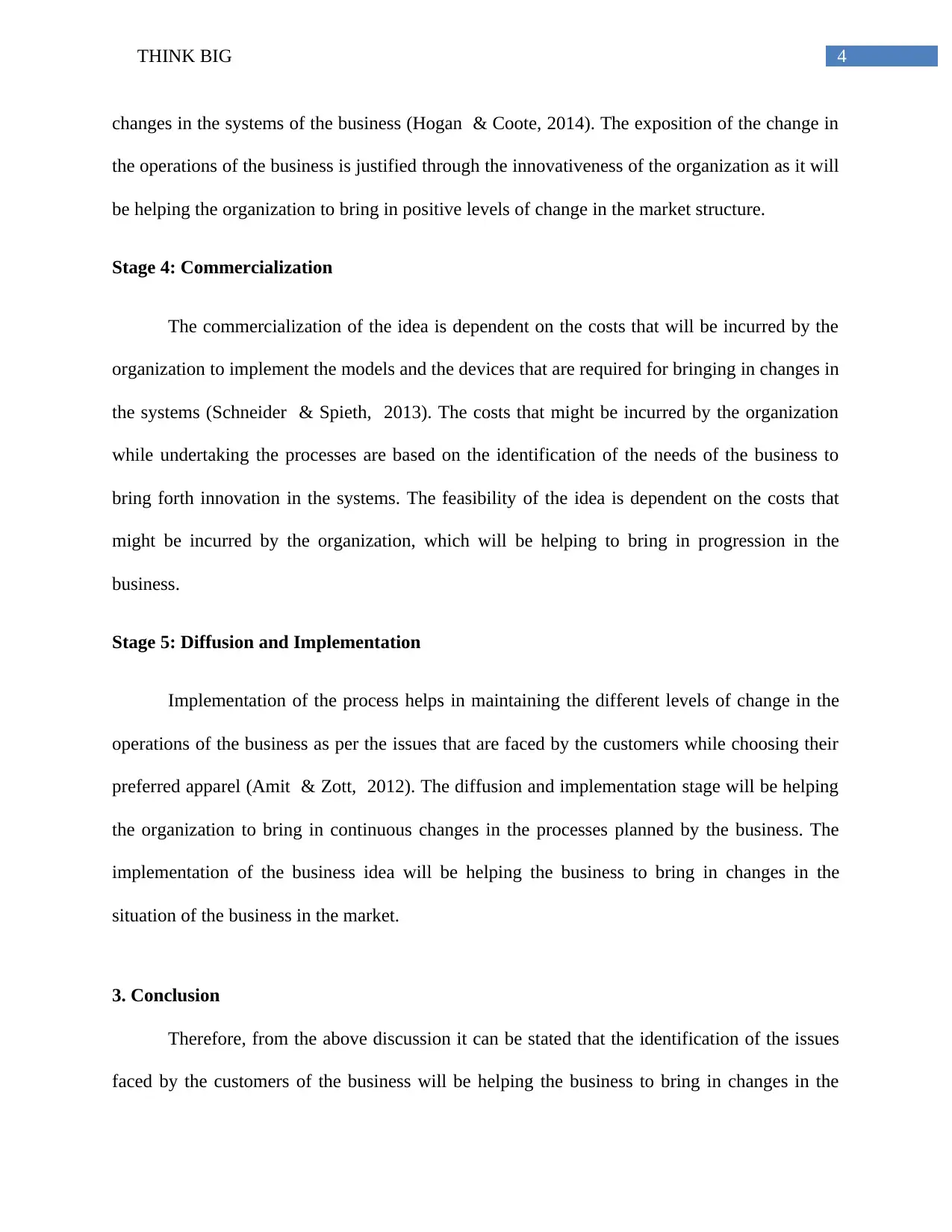
4THINK BIG
changes in the systems of the business (Hogan & Coote, 2014). The exposition of the change in
the operations of the business is justified through the innovativeness of the organization as it will
be helping the organization to bring in positive levels of change in the market structure.
Stage 4: Commercialization
The commercialization of the idea is dependent on the costs that will be incurred by the
organization to implement the models and the devices that are required for bringing in changes in
the systems (Schneider & Spieth, 2013). The costs that might be incurred by the organization
while undertaking the processes are based on the identification of the needs of the business to
bring forth innovation in the systems. The feasibility of the idea is dependent on the costs that
might be incurred by the organization, which will be helping to bring in progression in the
business.
Stage 5: Diffusion and Implementation
Implementation of the process helps in maintaining the different levels of change in the
operations of the business as per the issues that are faced by the customers while choosing their
preferred apparel (Amit & Zott, 2012). The diffusion and implementation stage will be helping
the organization to bring in continuous changes in the processes planned by the business. The
implementation of the business idea will be helping the business to bring in changes in the
situation of the business in the market.
3. Conclusion
Therefore, from the above discussion it can be stated that the identification of the issues
faced by the customers of the business will be helping the business to bring in changes in the
changes in the systems of the business (Hogan & Coote, 2014). The exposition of the change in
the operations of the business is justified through the innovativeness of the organization as it will
be helping the organization to bring in positive levels of change in the market structure.
Stage 4: Commercialization
The commercialization of the idea is dependent on the costs that will be incurred by the
organization to implement the models and the devices that are required for bringing in changes in
the systems (Schneider & Spieth, 2013). The costs that might be incurred by the organization
while undertaking the processes are based on the identification of the needs of the business to
bring forth innovation in the systems. The feasibility of the idea is dependent on the costs that
might be incurred by the organization, which will be helping to bring in progression in the
business.
Stage 5: Diffusion and Implementation
Implementation of the process helps in maintaining the different levels of change in the
operations of the business as per the issues that are faced by the customers while choosing their
preferred apparel (Amit & Zott, 2012). The diffusion and implementation stage will be helping
the organization to bring in continuous changes in the processes planned by the business. The
implementation of the business idea will be helping the business to bring in changes in the
situation of the business in the market.
3. Conclusion
Therefore, from the above discussion it can be stated that the identification of the issues
faced by the customers of the business will be helping the business to bring in changes in the
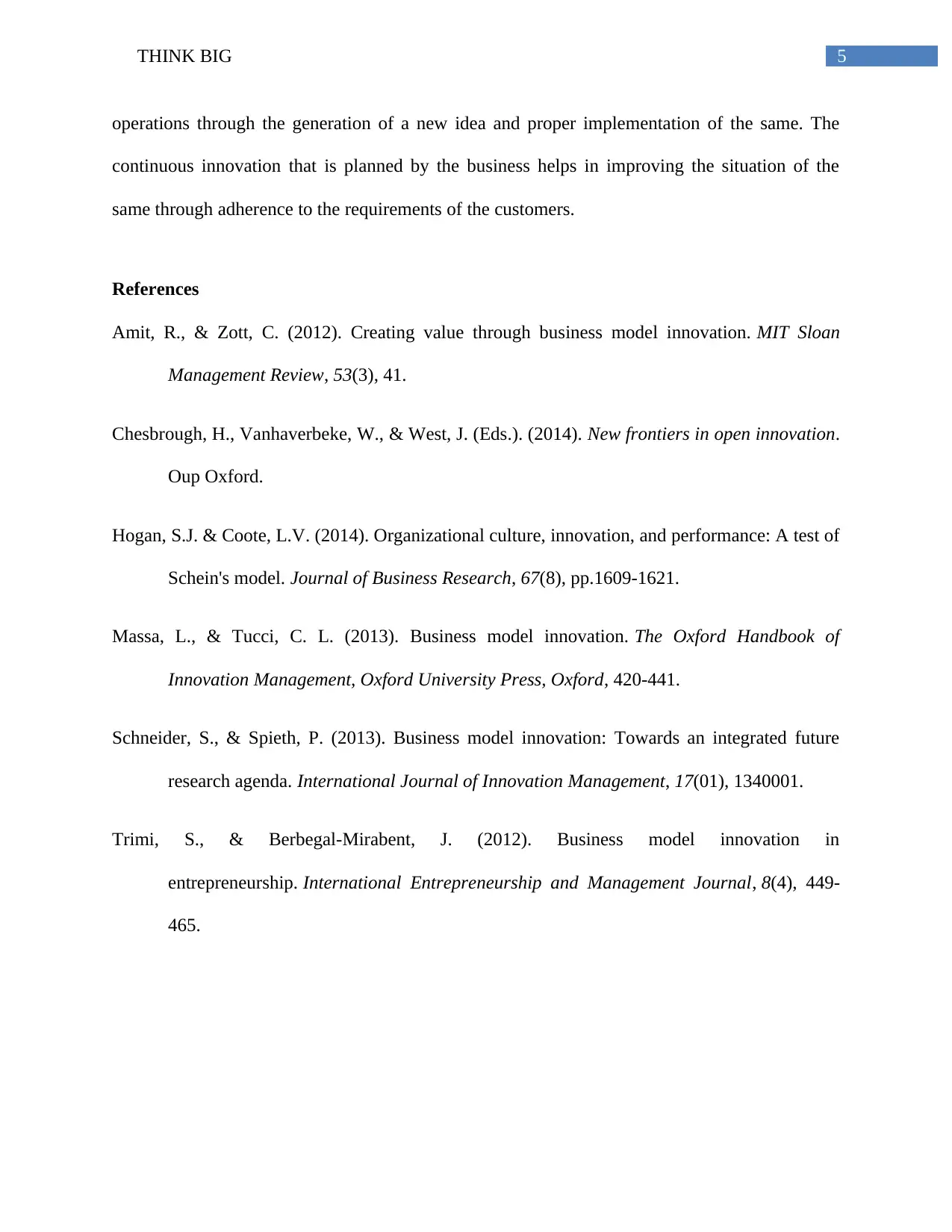
5THINK BIG
operations through the generation of a new idea and proper implementation of the same. The
continuous innovation that is planned by the business helps in improving the situation of the
same through adherence to the requirements of the customers.
References
Amit, R., & Zott, C. (2012). Creating value through business model innovation. MIT Sloan
Management Review, 53(3), 41.
Chesbrough, H., Vanhaverbeke, W., & West, J. (Eds.). (2014). New frontiers in open innovation.
Oup Oxford.
Hogan, S.J. & Coote, L.V. (2014). Organizational culture, innovation, and performance: A test of
Schein's model. Journal of Business Research, 67(8), pp.1609-1621.
Massa, L., & Tucci, C. L. (2013). Business model innovation. The Oxford Handbook of
Innovation Management, Oxford University Press, Oxford, 420-441.
Schneider, S., & Spieth, P. (2013). Business model innovation: Towards an integrated future
research agenda. International Journal of Innovation Management, 17(01), 1340001.
Trimi, S., & Berbegal-Mirabent, J. (2012). Business model innovation in
entrepreneurship. International Entrepreneurship and Management Journal, 8(4), 449-
465.
operations through the generation of a new idea and proper implementation of the same. The
continuous innovation that is planned by the business helps in improving the situation of the
same through adherence to the requirements of the customers.
References
Amit, R., & Zott, C. (2012). Creating value through business model innovation. MIT Sloan
Management Review, 53(3), 41.
Chesbrough, H., Vanhaverbeke, W., & West, J. (Eds.). (2014). New frontiers in open innovation.
Oup Oxford.
Hogan, S.J. & Coote, L.V. (2014). Organizational culture, innovation, and performance: A test of
Schein's model. Journal of Business Research, 67(8), pp.1609-1621.
Massa, L., & Tucci, C. L. (2013). Business model innovation. The Oxford Handbook of
Innovation Management, Oxford University Press, Oxford, 420-441.
Schneider, S., & Spieth, P. (2013). Business model innovation: Towards an integrated future
research agenda. International Journal of Innovation Management, 17(01), 1340001.
Trimi, S., & Berbegal-Mirabent, J. (2012). Business model innovation in
entrepreneurship. International Entrepreneurship and Management Journal, 8(4), 449-
465.
⊘ This is a preview!⊘
Do you want full access?
Subscribe today to unlock all pages.

Trusted by 1+ million students worldwide
1 out of 6
Related Documents
Your All-in-One AI-Powered Toolkit for Academic Success.
+13062052269
info@desklib.com
Available 24*7 on WhatsApp / Email
![[object Object]](/_next/static/media/star-bottom.7253800d.svg)
Unlock your academic potential
Copyright © 2020–2025 A2Z Services. All Rights Reserved. Developed and managed by ZUCOL.




